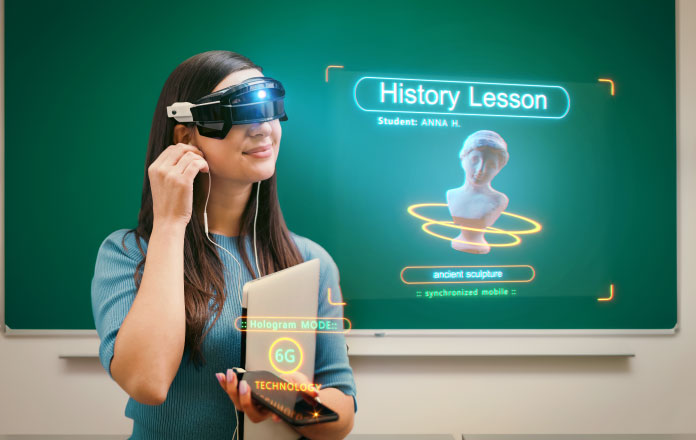The merging of Augmented Reality (AR) and Virtual Reality (VR) technology has brought about a revolutionary transition in the education industry in recent years. These immersive technologies have not only captivated the attention of students but have also opened new avenues for interactive and engaging learning experiences. The AR and VR in the education market are rapidly expanding, creating a dynamic shift in the traditional classroom setting.
AR and VR Defined:
Augmented Reality overlays digital content onto the real world, enhancing the user’s perception by adding computer-generated elements to their physical environment. On the other hand, Virtual Reality creates an immersive experience, transporting users to a simulated environment through the use of specialized headsets.
Benefits in Education:
- Enhanced Engagement: AR and VR technologies provide a multisensory experience, making learning more engaging and interactive. Students can explore historical landmarks, dissect virtual organisms, or even travel through the human body, creating a deeper understanding of complex subjects.
- Real-world Simulations: VR allows students to engage in realistic simulations that replicate scenarios they may encounter in their future careers. For instance, medical students can practice surgeries in a virtual operating room, enhancing their practical skills before stepping into a real-life setting.
- Personalized Learning: AR and VR enable personalized learning experiences tailored to individual students’ needs. Adaptive content and simulations are effective for catering to various learning styles, ensuring that each student comprehends and retains information at their own pace.
- Global Collaboration: Virtual classrooms break down geographical barriers, fostering global collaboration among students. AR and VR make it possible for students from different parts of the world to work together on projects, share cultural experiences, and broaden their perspectives.
Market Growth and Trends:
The AR and VR education market is experiencing exponential growth, driven by increased investment in educational technology and the demand for innovative learning solutions. According to industry reports, the market is projected to reach unprecedented heights in the coming years, with a compound annual growth rate (CAGR) that reflects the widespread adoption of these technologies in schools and universities worldwide.
Several Key Trends are Shaping AR and VR in the Education Market:
- Content Development: A surge in content development for AR and VR applications is observed, catering to various subjects and educational levels. Educational content creators are focusing on developing immersive experiences that align with curriculum standards and learning objectives.
- Affordable Hardware Solutions: The cost of AR and VR hardware has decreased, making these technologies more accessible to educational institutions. Affordable VR headsets and AR-enabled devices are becoming commonplace in classrooms, contributing to increased adoption rates.
- Integration with LMS: Integrating AR and VR modules into Learning Management Systems (LMS) allows educators to seamlessly incorporate immersive content into their teaching methods. This integration streamlines the learning experience, making it easier for teachers to manage and track student progress.
The integration of AR and VR in education is propelling traditional teaching methods into a new era of immersive and interactive learning. As the market continues to grow, educators and institutions must adapt to these transformative technologies to equip students with the skills needed for the future. The synergy between technology and education is reshaping the landscape of classrooms, fostering creativity, collaboration, and a deeper understanding of the world. The AR and VR in the education market are not just about gadgets; it’s about empowering the next generation with the tools they need to excel in an increasingly digital and interconnected world.




